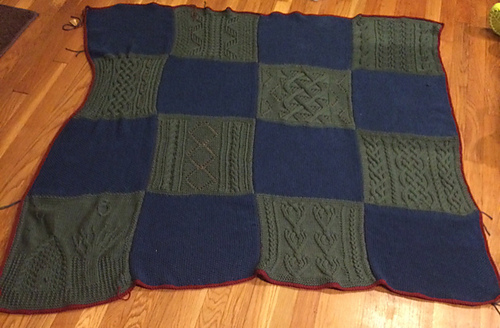by Terri
A week ago, thanks to the generosity of a friend, I got to go to the New York Sheep & Wool Festival in Rhinebeck, NY for the first time. Typically referred to as "Rhinebeck" by fiber artists, this is one of the biggest festivals of its kind in America.
Three sheep (2 with white wool, one with grey) with numbers on their butts. The sheep have recently had haircuts, and their fleeces were likely for sale at the show.
Maple cotton candy in bags hanging from a clothesline. It really looks like undyed wool for spinning. Watching people eat it is slightly disconcerting. It is delicious.
As the title of this blog post suggests, Rhinebeck (and other large sheep and wool festivals) is basically FiberCon, though weighted much heavier towards the Dealer's Room and Art Show and very light on the panels.* There are show presentations of sheep, goats and alpacas; and live demonstrations of sheepdogs herding sheep. Typically there is at least one Sheep to Shawl competition. There are tons of food vendors, people selling jewelry, clothing, edible roving (otherwise known as maple cotton candy), and all sorts of tools for fiber artists.
But the main attraction is the yarn. Barns and barns crammed full of yarn and spinning fiber in every color of the rainbow (and a few colors that the rainbow wishes it could come in). I wish I'd taken pictures, but I was too busy staring at all the pretty.
In some ways the festival was overwhelming. Even if I'd had an unlimited budget (I didn't) and the ability to carry anything I wanted to buy without getting tired (didn't have that either), I would still not have gotten everything I could have wanted. There was honestly too much to see and squish. (Given that we sell a card telling you that you don't have enough yarn, I know that can be hard to believe). I did blow through my budget twice (my friend is a wonderful, though expensive, enabler) and got some yarn that I never otherwise would have seen. I have plans for most of it, and may feature some if it here on the blog when it's finished.
The haul:
So much yarn in all the colors.
Clockwise for the top left: A Gale’s Art gradient set in Wild Berries on their MYS 622 base (Superwash merino, yak, & silk), an Indigo Dragonfly Trimorphs Gradient set in Gothic Unicorn on the CaribouBaa base (100% superwash merino) with a set of 8 purple buttons from Jennie the Potter, a tin of lavender and mint solid lotion from Heal My Hands, a Gale’s Art Sparkle Sock Blank in Rockstar Rainbow, a skein of Miss Babs Yowza in Iolite, the Dragonfly Fibers Rhinebeck exclusive colorway on the Damsel base, and skein of Harvest Yarns Minty Mix from Sweitzer’s Fiber Mill (no colorway given, it’s a sort of purple grey. The base is 80% merino, 20% mint fiber).
All in all, a lovely way to spend a fall Sunday. I'm looking forward to coming back next year.
*And unless you count the fabulous haircuts** on some of the llamas and alpacas, no Masquerade to speak of.
**Example of a camelid with a fabulous haircut:
Cream camelid with brown spots with a poodle-style haircut.



















